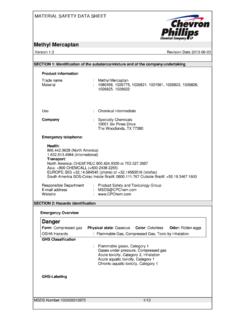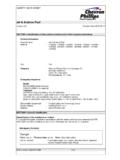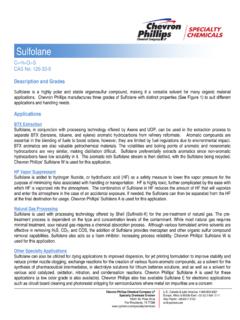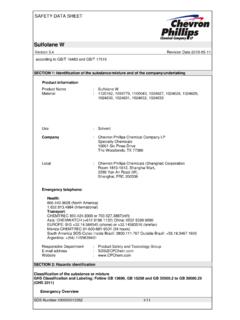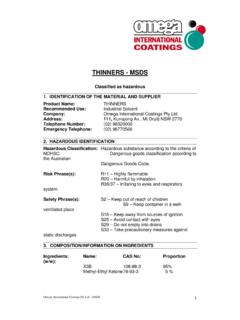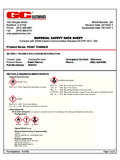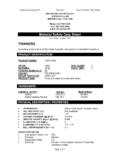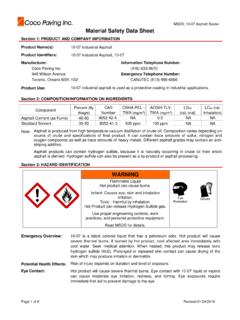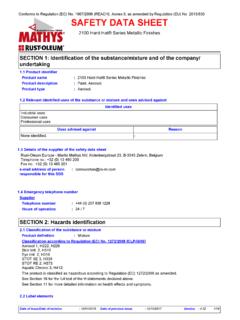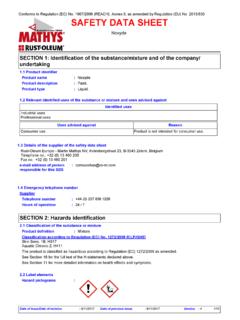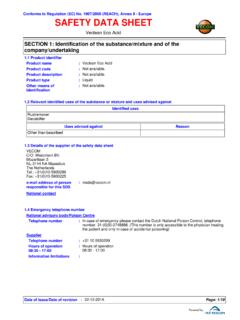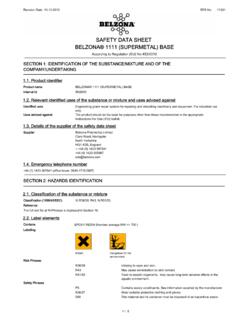Transcription of Marlex® HHM 5502BN Polyethylene
1 SAFETY DATA SHEET marlex HHM 5502BN Polyethylene Version Revision Date 2018-02-08 SDS Number:100000000723 1/11 SECTION 1: Identification of the substance/mixture and of the company/undertaking Product information Product Name : marlex HHM 5502BN Polyethylene Material : 1120264, 1120263, 1120262, 1120191, 1120190, 1018781, 1018783, 1079987, 1079986, 1079983, 1079982, 1079988, 1061818, 1079981, 1079985, 1079984, 1018060, 1018064, 1025220, 1019346, 1018782, 1019345, 1019347, 1019348, 1019349, 1019350, 1018785, 1018784 Company : Chevron Phillips Chemical Company LP 10001 Six Pines Drive The Woodlands, TX 77380 Emergency telephone: Health: (North America) (International) Transport: CHEMTREC or (int'l) Asia: CHEMWATCH (+612 9186 1132) China: 0532 8388 9090 EUROPE: BIG + (phone) or + (telefax) Mexico CHEMTREC 01-800-681-9531 (24 hours) South America SOS-Cotec Inside Brazil: Outside Brazil: + Argentina: +(54)-1159839431 Responsible Department : Product Safety and Toxicology Group E-mail address : Website : MEDICAL APPLICATION CAUTION: Do not use this material in medical applications involving permanent implantation in the human body or permanent contact with internal body fluids or tissues fluids or tissues.
2 Do not use this material in medical applications involving brief or temporary implantation in the human body or contact with internal body fluids or tissues unless the material has been provided directly from Chevron Phillips Chemical Company LP or its legal affiliates under an agreement which expressly acknowledges the contemplated use. Chevron Phillips Chemical Company LP and its legal affiliates makes no representation, promise, express warranty or implied warranty concerning the suitability of this material for use in implantation in the human body or in contact with internal body fluids or tissues. SAFETY DATA SHEET marlex HHM 5502BN Polyethylene Version Revision Date 2018-02-08 SDS Number:100000000723 2/11 SECTION 2: Hazards identification Classification of the substance or mixture This product has been classified in accordance with the hazard communication standard 29 CFR ; the SDS and labels contain all the information as required by the standard.
3 Classification : Combustible dust Labeling Signal Word : Warning Hazard Statements : May form combustible dust concentrations in air. While this product may not be a combustible dust as sold, further processing or handling may form combustible dust concentration in air. Potential Health Effects Physical Hazards : Pellets may cause a slip hazard on hard surfaces. Mechanical processing may form combustible dust concentrations in air and thermal processing at elevated temperatures may generate formaldehyde. Inhalation : Repeated exposure to dust from this material may cause respiratory irritation. Fumes generated during thermal processing may cause irritation of the upper respiratory tract.
4 Skin : Contact with the skin is not expected to cause prolonged or significant irritation. Contact with the skin is not expected to cause an allergic response. If this material is heated, thermal burns may result from contact. Thermal burns may include pain or feeling of heat, discolorations, swelling, and blistering. Eyes : Contact with the eyes may cause irritation due to the abrasive action. Not expected to cause prolonged or significant eye irritation. Thermal burns may result if heated material contacts eye. Ingestion : Ingestion of this product is not a likely route of exposure. Carcinogenicity: IARC No ingredient of this product present at levels greater than or equal to is identified as probable, possible or confirmed human carcinogen by IARC.
5 NTP No ingredient of this product present at levels greater than or equal to is identified as a known or anticipated carcinogen by NTP. SAFETY DATA SHEET marlex HHM 5502BN Polyethylene Version Revision Date 2018-02-08 SDS Number:100000000723 3/11 SECTION 3: Composition/information on ingredients Component CAS-No. Weight % Polyethylene Hexene Copolymer 25213-02-9 99 - 100 SECTION 4: First aid measures If inhaled : Move to fresh air in case of accidental inhalation of dust or fumes from overheating or combustion. If symptoms persist, call a physician. In case of skin contact : If the molten material gets on skin, quickly cool in water. Seek immediate medical attention.
6 Do not try to peel the solidified material from the skin or use solvents or thinners to dissolve it. In case of eye contact : In the case of contact with eyes, rinse immediately with plenty of water and seek medical advice. If swallowed : Do not induce vomiting without medical advice. SECTION 5: Firefighting measures Flash point : No data available Autoignition temperature : No data available Suitable extinguishing media : Water. Water mist. Dry chemical. Carbon dioxide (CO2). Foam. If possible, water should be applied as a spray from a fogging nozzle since this is a surface burning material. The application of high velocity water will spread the burning surface layer.
7 Avoid the use of straight streams that may create a dust cloud and the risk of a dust explosion. Use extinguishing measures that are appropriate to local circumstances and the surrounding environment. Specific hazards during fire fighting : Risks of ignition followed by flame propagation or secondary explosions can be caused by the accumulation of dust, on floors and ledges. Special protective equipment for fire-fighters : Use personal protective equipment. Wear self-contained breathing apparatus for firefighting if necessary. Further information : This material will burn although it is not easily ignited. Fire and explosion protection : Treat as a solid that can burn.
8 Avoid generating dust; fine dust dispersed in air in sufficient concentrations, and in the presence of an ignition source is a potential dust explosion hazard. Hazardous decomposition products : Normal combustion forms carbon dioxide, water vapor and may produce carbon monoxide, other hydrocarbons and hydrocarbon oxidation products (ketones, aldehydes, organic SAFETY DATA SHEET marlex HHM 5502BN Polyethylene Version Revision Date 2018-02-08 SDS Number:100000000723 4/11 acids) depending on temperature and air availability. Incomplete combustion can also produce formaldehyde. SECTION 6: Accidental release measures Personal precautions : Sweep up to prevent slipping hazard.
9 Avoid breathing dust. Avoid dust formation. Environmental precautions : Do not contaminate surface water. Prevent product from entering drains. Methods for cleaning up : Clean up promptly by sweeping or vacuum. Additional advice : Dust deposits should not be allowed to accumulate on surfaces, as these may form an explosive mixture if they are released into the atmosphere in sufficient concentration. Avoid dispersal of dust in the air ( , clearing dust surfaces with compressed air). SECTION 7: Handling and storage Handling Advice on safe handling : Use good housekeeping for safe handling of the product. Keep out of water sources and sewers. Spilled pellets and powders may create a slipping hazard.
10 Electrostatic charge may accumulate and create a hazardous condition when handling this material. To minimize this hazard, bonding and grounding may be necessary, but may not by themselves be sufficient. At elevated temperatures (>350 F, >177 C), Polyethylene can release vapors and gases, which are irritating to the mucous membranes of the eyes, mouth, throat, and lungs. These substances may include acetaldehyde, acetone, acetic acid, formic acid, formaldehyde and acrolein. Based on animal data and limited epidemiological evidence, formaldehyde has been listed as a carcinogen. Following all recommendations within this SDS should minimize exposure to thermal processing emissions.
